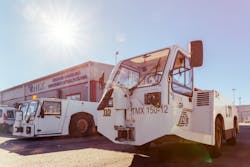With the applicability, as of November 2015, of Regulation (EU) No. 376/2014 and Commission Implementing Regulation (EU) 2015/1018 dealing with the reporting, analysis and follow-up of occurrences in civil aviation, aircraft ground handling companies in Europe are being more consistently requested to contribute to a European central repository of safety information that includes both mandatory and non-mandatory occurrence reports.
This requirement is set to establish some critical mass for ground handling companies to further enhance their safety management systems (SMS) by means of an increased scrutiny on safety reporting.
The two regulations serve two different, yet complementary, purposes.
- Regulation (EU) No. 376/2014 provides for the requirements of the various different stakeholders, namely the European Commission, the European Aviation Safety Agency (EASA), the various European national aviation authorities (NAA) and the individual aeronautical service providers – including aircraft ground handling companies, in terms of what they are to do to sustain the development of a pan-European system of safety information collection, consolidation and dissemination.
- Commission Implementing Regulation (EU) 2015/1018 provides a list classifying occurrences in civil aviation to be mandatorily reported in accordance with Regulation (EU) No 376/2014.
Annex IV of Regulation (EU) 2015/1018 provides a list of occurrences related specifically to aerodromes and ground services. These are classified under two main headings: ‘safety management of an aerodrome’ and ‘ground handling of an aircraft’.
Under ‘ground handling of an aircraft,’ a series of ground handling specific occurrences is determined that aircraft ground handling companies need to memorize and mandatorily report when experienced. This list is more comprehensive than the list of ground handling reportable occurrences that was applicable before Regulation (EU) No. 376/2014 and Commission Implementing Regulation (EU) 2015/1018 became applicable.
The list includes the incorrect handling or loading of passengers, baggage, mail or cargo, likely to have a significant effect on aircraft mass and/or balance (including significant errors in load sheet calculations); boarding equipment removed leading to endangerment of aircraft occupants; incorrect stowage or securing of baggage, mail or cargo likely in any way to endanger the aircraft, its equipment or occupants or to impede emergency evacuation; and the transport or attempted transport or handling of dangerous goods which resulted, or could have resulted, in the safety of the operation being endangered or led to an unsafe condition — for example, dangerous goods incident or accident as defined in the ICAO Technical Instructions for The Safe Transport of Dangerous Goods by Air (ICAO — Doc 9284).
Other mandatorily reportable ground handling occurrences include:
- The non-compliance on baggage or passenger reconciliation.
- The non-compliance with required aircraft ground handling and servicing procedures, especially in deicing, refuelling or loading procedures, including incorrect positioning or removal of equipment, significant spillage during fuelling operations, the loading of incorrect fuel quantities likely to have a significant effect on aircraft endurance, performance, balance or structural strength and the loading of contaminated or incorrect type of fuel or other essential fluids (including oxygen, nitrogen, oil and potable water).
The following occurrences are also to be reported:
- Failure, malfunction or defect of ground equipment used for ground handling, resulting into damage or potential damage to the aircraft — for example: tow bar or GPU.
- Missing, incorrect or inadequate deicing/anti-icing treatment.
- Damage to aircraft by ground handling equipment or vehicles, including previously unreported damage and any occurrence where the human performance has directly contributed to, or could have contributed to, an accident or a serious incident.
Thanks also to the fact that SMS have become mandatory for airlines in Europe and that these are increasingly demanding that their ground service providers implement more thorough forms of safety reporting, this practice on the ramp is already improving in the experience of aircraft ground handling companies.
According to Joseph Zammit, head of ground handling at Air Malta — which self-handles at its main station at Malta International Airport, safety reporting has increased significantly due to the SMS framework and its promotion. He highlights some data from Air Malta’s main station where in 2014, the introductory year, there were 26 reports; these increased to 61 in 2015 and reached 52 at the end of November 2016. According to Zammit this is a steady increase that denotes the proactivity of well informed and trained ramp employees to come forward and start alerting safety concerns to management.
An increase in safety reporting is a consequence of efforts that have been committed to promote a just culture in the ground handling environment.
“There are enough civil aviation legislation frameworks that protect and develop a just culture environment in aviation and its related ground service habitat,” says Zammit. “What is required is a further push towards better communication, training initiatives and a wholesome effort by all post holders towards the protection of employee trust and a development of preventive actions that are beneficial to both operative staff and management.”
“In our case, the senior management is confident that we follow the principles of a just culture. The safety policy also confirms this,” says Laura Karnite, a spokesperson for Riga International Airport in Latvia. “There is a need to ensure that, in cases of a safety incident, it is first evaluated why the incident occurred; and only in cases where it is due to intentional negligence, action should be taken”.
While SMS is developing a critical mass within ground handling companies, it has an effect of increased reporting. SMS is still underdeveloped when compared with other more proactive domains of the aviation business such as flight operations. Indeed, there are barriers that are preventing safety reporting systems of European aircraft ground handling companies from developing their full potential.
According to Karnite, it should be taken into consideration that it is not only the aircraft ground handling companies that are operating in an environment where the safety management system operational framework applies. There are plenty of organizations – especially small organizations – that work in the safety sensitive environment of aircraft ground handling but do not participate directly in the aircraft servicing.
“However, they still have a serious impact on the maintenance of safety performance. These organizations often have no, or have very limited, knowledge of the necessity of the safety system and its operating principles,” she points out.
According to Zammit, other barriers that are preventing SMS to establish a solid critical mass in the handling side of the aviation business include the possible lack of educational background that could exist among operative employees finding it very hard to access software or share points to report.
“Another possible barrier is the lack of middle management engagement towards safety standards and framework requirements. This could lead to a communication gap that could raise barriers in facilitating safety reports,” he says.
The aim of regulators is that a consolidated pan-European aviation safety reporting, including the ground handling domain, will produce knowledge that will help to better assess contributory factors. According to Karnite, however, the issue is complex.
“In Europe there are serious differences in opinions and traditions in respect of safety reporting. How realistic is the possibility that the principles of the European safety management system are applied in one part of Europe the same way as in other parts? We should therefore work towards an EU-wide equal understanding of the nature of the SMS, its operation and application of the fundamental principles,” she says.
According to Zammit, this consolidation will definitely be beneficial as it may generate a harmonized safety and risk analysis through an improved data capture.
“A consolidated safety database will provide a better understanding of unsafe accident contributory factors and help assess risk and manage hazards,” he concludes.
About the Author

Mario Pierobon
Dr. Mario Pierobon provides solutions in the areas of documentation, training and consulting to organizations operating in safety-sensitive industries. He has conducted a doctoral research project investigating aircraft ground handling safety. He may be reached at [email protected].
